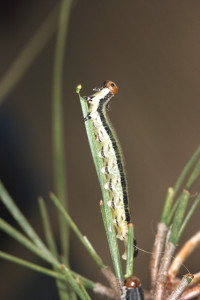
Pine sawflies resemble caterpillars, but have six or more fleshy prolegs, or "clasping legs" on their abdomen. True caterpillars have five or less clasping legs.
Pine sawflies resemble caterpillars, but have six or more fleshy prolegs, or “clasping legs” on their abdomen. True caterpillars have five or less clasping legs.
I just had a report from urban forester Pam Corder in Kaufman, TX. She reports an outbreak of sawfly caterpillars on pine trees in Kaufman County. Two years ago there was another outbreak of sawflies in Kaufman and several other counties just east of the Dallas area.
That outbreak was identified as Neodiprion taedae linearis, also known as the loblolly pine sawfly. Those insects from 2009 were a greenish species with dark longitudinal stripes and orange to black head capsules. Sawflies can be distinguished from true caterpillars (larvae of moths and butterflies) by a dark eye spot on the head, and 6 or more “clasping” legs on the abdomen (tail) of the body.
Sawflies are interesting in that, despite their caterpillar-like appearance, they are not true caterpillars from the order Lepidoptera. Instead they represent the only suborder of wasps (in the order Hymenoptera) that are plant feeders.
Leaves (needles) of infested pines may be chewed down to the fascicles at the base of the needle bunches. According to Pam, there are three times as many of these caterpillar this year feeding on trees compared to two years ago.
For more information, including control recommendations, check out my 2009 blog post.